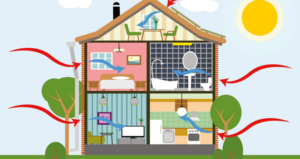
If you’re looking to buy or build an energy-efficient home, there are a few things you should know. While energy-efficient homes keep your utility costs down and can save you money in the long-run, they may be more expensive in the beginning and they do require some extra care.
If you’re building an energy-efficient home or your looking to buy one, here’s what you need to be looking for:
- They should work as a whole unit, not individual pieces for the best results. Each part affects the performance of the other parts, which in turn, affects the performance of the house as a whole unit. The energy-efficient aspects need to feed off each other or your home won’t run as efficiently as it could. If you’re building, make sure your architect and contractor understand your goal from the beginning. And if you’re buying, make sure each aspect is working well with the others; a home inspector familiar with energy-efficient homes can look for this.
- Get the best use of the sun by facing the home properly on the site. South facing rooms get sun most of the day, perfect for the main living areas. East facing rooms get good sun in the morning and stay cool in the afternoon and evening, which is perfect for bedrooms and kitchens. West facing rooms get afternoon sun so they get warmer late in the day, usually not the best placement for bedrooms and kitchens. And north facing rooms get little sunlight which is perfect for less used areas like garages, bathrooms, and laundry rooms.
- Continuous insulation is essential to energy-efficient homes. Continuous insulation is uncompressed and continuous across all of your structure. It does not allow for fasteners, service openings, or thermal bridges where heat and energy can flow through. Continuous insulation stops air leakage to save money and energy by reducing heating and cooling expenses.
- Cool roofs are best to keep the interior heat down. A cool roof protects against solar heat gain and keeps the house and attic space cool. Traditional roofing has a high thermal element that absorbs the sun’s heat and transfers it inside the home, which is why attics are usually so much hotter than the rest of the house. Cool roofs not only keep the interior comfortable and reduce energy bills, they also extend the life of the roof.
As you can see, there are several things you should be looking for when buying or building an energy-efficient home. There are also a few things to consider when it comes to maintaining the home. In order to keep an energy-efficient home working at its best, regular maintenance is necessary.
- HVAC filters need to be changed once a month to keep dirt, dust, and allergens from building up. Not only do you not want these components in the air you’re breathing, they can gunk up your HVAC system making it work harder than necessary.
- Routine maintenance of your appliances is a must. Keeping your dryer vent clean will prevent overheating and make your dryer run better. Refrigerators should be checked for leaking door seals and the cooling unit should be cleaned of dust and lint regularly.
- Window seals should be checked yearly to ensure the seal is in good working order and air is not getting in or escaping. Check your windows both outside and inside. Inside, feel around for any breeze coming in. Outside, look for visible damage, cracks, or broken seals to window panes and sills.
- Inspect air ducts regularly to remove any dirt, grime, dust, and especially mold that may be building up. This kind of inspection and cleaning should be done by an HVAC specialist once a year; they have the proper equipment and knowledge to clean out your duct work.
Buying or building an energy-efficient home comes with some extra work, and sometimes, extra expense, but the money you save over time is worth it. If your energy-efficient home is properly built and maintained, your utility bills will be significantly reduced for years to come.
Leave a Reply